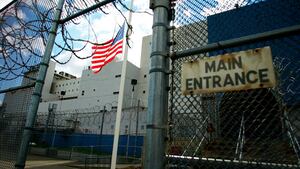There is just one epitaph in stone on Hart Island, perhaps the world’s largest public potter’s field, where more than a million New Yorkers of all ages have been laid to rest in coffins stacked in trenches for a century and a half. It ends:
Cry Not For Us
For We Are With The Father
No Longer Do We Cast Shadows
On the Ground As You Do
We Are At Peace.
The coronavirus is now killing more New Yorkers each day than heart attacks, cancer, murder, and every other cause of death here combined. With the city using refrigerated mobile morgues for the first time since 9/11, and with funeral homes, crematoriums and cemeteries designated as essential services struggling to keep pace with the virus, rumors have flown for weeks about the city’s plans for the dead. Mayor Bill de Blasio has insisted he wouldn’t go into the grim details about the “painful topic” but instead would keep his focus on saving lives.
That changed Monday, after City Council Health Chair Mark Levine, recently recovered from his own apparent coronavirus infection, tweeted that “Soon we’ll start ‘temporary interment’. This likely will be done by using a NYC park for burials (yes you read that right). Trenches will be dug for 10 caskets in a line.”
That “news,” which Levine later “clarified” was a contingency plan that won’t be needed if death rates stay flat, as they have for the past two days, forced de Blasio to acknowledge that “if there was ever going to need to be a place for burial, it would be Hart Island, where burials are already done.” Those would mostly be temporary burials, City Hall noted, until people could identify and claim family members.
Burials on Hart Island have always been the duty of the city’s Department of Correction, with labor provided by inmates serving misdemeanor sentences of less than a year in Rikers Island (where 273 inmates had tested positive for the virus as of Sunday, and where the first inmate died from it on Monday). They are ferried to Hart Island once a week and were paid just $1 an hour until earlier this year.
The jail is scheduled to close by 2026, and its population has declined in recent years as a result of various criminal justice reforms, shrinking the worker pool. In recent weeks, as the virus has redefined the common meaning of the term “public safety concern,” The Intercept reported that inmates are now being offered $6 an hour—making it the jailhouse equivalent of a 1-percenter gig—and personal protective equipment to work on Hart Island, where the number of burials tripled last week. The city says that work is not “COVID-specific,” and de Blasio has said repeatedly that he wouldn’t use inmate labor for coronavirus victims there.
Along with countless victims of the Spanish Flu, Hart Island also houses the remains of many people who died of AIDS-related complications in the '80s, when funeral directors were advised not to embalm or handle their remains. Those included 17 unidentified corpses that arrived in 1985 that were “kept out of the trenches and instead quarantined in a remote spot on the island’s southernmost tip, buried deep in individual graves,” as Corey Kilgannon recounted in The New York Times, quoting a retired DOC captain who recalled, “This was a scary time and people were avoiding AIDS patients like the plague.”
The odd thing about de Blasio’s reticence in discussing where coronavirus victims would be buried if needed, said Melinda Hunt of the Hart Island Project, is that the city does have a solid plan, if needed, for mass burials. The issue, she said, has been a failure to communicate on the part of the mayor:
“This is the same plan that was used for temporarily buried Union soldiers on the battlefield, so that they could go back and disinter them and rebury them in national cemeteries after the war. So this is a long tried and tested system of burials, and New York city actually does have capacity for whatever the number of deaths there are. It’s just not a problem.”
She noted that drone footage of recent burials there (the Parks Department will take control of the island by next year, but in the meantime it’s difficult to visit and cameras are prohibited) shows that the DOC is now using a forklift to put coffins in trenches. A machine does the digging and just three inmates are needed to guide coffins into place. Another 10 shovel the dirt back, she said, and “that system of burials is highly efficient. They can bury 25 bodies in an hour. That’s really doable if all you need is 13 guys.”
And in a city where even private graveyard space is a scarce and pricey commodity, there’s no capacity issue on Hart Island, Hunt notes, since “it’s legal to reuse graves that are over 25 years” old, which covers most of the graves there.
“The way they’ve done it in the past is they’ve moved all the bones to one end and then just started over. So it means that you’re mixing the burials within that grave, but they’re already kind of mixed because the boxes have decomposed and the bodies have fully decomposed because there’s no embalming,” she said. “It’s a common grave, sort of like a family tomb that when the younger generation dies and the bones of the older generation are moved to the back. So it’s not removing anyone from Hart Island or even from their plot, but it’s making room for new burials. They haven’t done it since the '70s, but before that they regularly reused graves.”
And, she noted, since each coffin has a specific location in its trench, which essentially acts as a grid, disinterments of known corpses could be easily done as needed following a surge in burials.
So, says Hunt, “I think we should not be worrying about the burials. I think the city does have capacity and especially if they start talking about it differently, it’ll be fine. The mayor needs to talk about it in plain language, like the governor does:
“Yeah. You don’t have a ventilator, you die. That’s it, guys. And same thing as you run out of funeral directors and the crematoriums are at capacity. The city has to bury your relative and then we’ll sort it out later.”
Besides, she said, “Hart Island is a very beautiful cemetery. The private cemeteries don’t have enough burial space. There’s not enough space except on Hart Island.”


